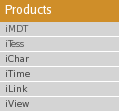The reverse biased source and drain junctions to the well are a source of this leakage.
- One of the components of this are the minority carrier drift/diffusion
currents at the edge of the depletion layer. - The other leakage component is the
current due to electron-hole pair generation in the depletion region of the PN junction. - In short channel devices if the source and drain are heavily doped
there could be band-to-band tunneling through the combined depletion regions of
the drain and source.
| Top^ |
2. Sub-threshold Leakage
This the current between the source and drain when the transistor is OFF or the
gate is below the threshold voltage. The transistor is in weak inversion wherein
the minority carriers are small in number but not zero.
-
The threshold voltage is independent of the drain bais and channel length but
in short channel devices the threshold voltage gets modulated by the drain voltage.
As the drain voltage is increased the barrier potential decreases due the drain
and source depletion regions interacting at the channel surface. This effect is
called drain induced barrier lowering (DIBL). - Narrow width devices result in an increase in the threshold voltage due to the
fring fields generated by the gate which induce depletion regions which extend
beyond the defined channel width - In short channel devices the depletion regions around the drain and source are
comparable in width to the vertical depletion region. This causes the channel to
be already depleted lowering the threshold voltage which in turn causes
sub-threshold leakage.
| Top^ |
3. Gate-Oxide Tunneling Leakage
Reduction of gate oxide thickness results in an increase in the field across the
oxide. The high electric field coupled with low oxide thickness results in tunneling
of electrons from substrate to gate and also from gate to substrate through the
gate oxide, resulting in the gate oxide tunneling current.
| Top^ |
4. Hot Carrier Injection Leakage
Due to high electric fields near the channel-oxide interface, electrons or holes can
gain sufficient energy from the electric field to cross the interface potential
barrier and enter into the oxide layer. This effect is known as hot-carrier injection.
The chances of electron injection is higher than holes because of it lower effective mass.
| Top^ |
5. Gate-Induced Drain Leakage
High electric fields in the drain junction cause minority carriers to be emitted
in the drain region under the gate. Thinner oxide in short channel devices and higher
gate and drain potential further enhances this effect.
| Top^ |
6. Drain-Source Punchthrough Leakage
In short-channel devices, due to the proximity of the drain and the source, the
depletion regions at the drain-substrate and source-substrate junctions extend into
the channel which in turn could collapse into each other at the surface resulting
in decreased threshold votlage and increased leakage.
| Top^ |
7. Drain-Induced Gate Leakage
Due to high electric fields in the gate-drain overlap region minority carriers
get accelerated and trapped in the gate oxide region affecting the threshold
voltage and leakage current.
| Top^ |






